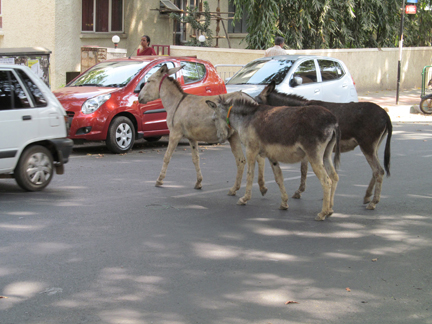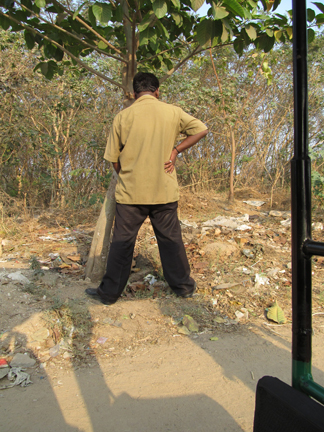Sumandro
“Commons are forms of direct access to social wealth; access that is not mediated by competitive market relations.”
– Massimo De Angelis, The New Commons in Practice: Strategy, Process and Alternatives, Development, 2005, 48(2), 48-52

Men gathering cattle fodder, Yelahanka
In the interview with The Ugly Indian published previously here, the explanation of the messy situation of Bangalore’s garbage management system rests on issues of ownership, incentive design and systemic conflicts. TUI and Suketu Mehta tell us that Indians are not ‘altruistic’ when it comes to looking after spaces not ‘owned’ by them. This opinion (about the ‘dirty Indians’) has not changed much since colonial times when British administrators and travelers complained endlessly about the shabby state of Indian public spheres. V.S. Naipaul continues the anxiety as he writes: “Indians defecate everywhere. They defecate, mostly beside the railway tracks. But they also defecate on the hills; they defecate on the river banks; they defecate on the streets; they never look for cover.” In TUI’s own strategy, fighting public urination comes right along with fighting public littering.
But what is the public sphere in India? Does it map neatly onto a Western notion of the ‘public’? For example, the shopkeeper who sweeps the public street immediately adjacent to his/her shop, or the lady who draws rangoli (religious-ornamental pattern on the ground/street surface) in front of her house but on the street, why are they integrating a part of the ‘public’ into their ‘private’? Because they feel ownership of those places? Do Indian men urinate in ‘public’ because they treat it as their ‘private’ space and hence feel ownership enough to undertake such private missions? Or is it because they do not feel any ownership at all towards ‘public’ space and hence decide to litter or deteriorate the quality of the same through other means? In that case, how come they also arrange concrete slabs on the pavement around tea stalls and improve the quality of the space by supplying DIY street furniture? Or are public space usage and activities context specific? Especially, do they respond to the urban design and social usage features of the place in question?

Donkeys crossing Venkata Ranga Iyengar Road, Mallesvaram
TUI suggests two strategies to tackle this mass culture of public littering: (1) the big government way, with a perfectly coordinated garbage collection system along with streamlined and incentivised user participation, and (since that seems to be impossible given the present environment of garbage mafia and vote-seeking politicians) (2) citizen action supported by peer pressure and public shaming. The first suggestion fits very well with the ‘tragedy of commons’
understanding of the situation — garbage gathers at places that are ‘commons,’ that is, not owned by anyone and hence not cleaned by anyone, and can only be managed (or cleaned) by either giving the control of the ‘commons’ to the government or by privatising it. The second suggestion, which is the actual practice of TUI, however, is strange and creative. It is strange because given TUI’s belief in the ‘tragedy of commons’ theory, clearly they should know that periodic vigilance cannot solve the tragedy due to the presence of ‘free riders’ (ones who will use the resource without paying for it). It is creative because TUI attempts to minimize free riding through public shaming – an innovative twist to the old discussions about managing commons1. Now public shaming works if the activity is deemed to be shameful, and hence comes TUI’s project of changing the culture of public spaces.
David (Stairs) asks TUI about the possibility of new symbols to support and spearhead this cultural campaign. As TUI suggests social behavioural change (through shaming) as the solution for public littering, it is only expected that re-designing cultural symbols would add to the effort. TUI, however, tells David that the fundamental challenge is of insufficient infrastructure (litter
bins, urinals etc.). The cultural form of ubiquitous dirty public spaces is embedded onto a citywide lack of public infrastructure. This question of infrastructure is crucial in understanding the cityscape of dirty public spaces and fenced up private plots. On one hand, it reflects the high modernist ideal of a well-designed city, with coordinated and designated spaces programmed for all possible human activities – the city as a machine for living in. In order to achieve this the city not only needs specified spaces for all human activities, but also a monitoring and disciplining system to ensure that the activities are not overflowing beyond designated spaces. On the other, it makes one think of all the various public infra-structural elements that the city must provide so as to ensure a clean and hygienic public realm.

Rickshaw driver urinating on the roadside
Think of all the activities that take place in public spaces in Indian cities: cooking, grazing, washing (clothes, utensils, as well as the human body), harvesting, reading newspapers, post-work chats, sleeping (afternoon nap and night sleep) etc. One is suddenly aware of not only litter bins and urinals but an enormous infrastructural lack underlying the public culture and space occupancy of Indian cities. This is no longer an issue of street furniture and pedestrian infrastructure, but one of a deep structural refusal of the rights of the poorer urban classes.
In the face of this indifference by the urban powers that be, the public space in Indian cities is transformed into a ‘common’ by these classes. As De Angelis describes, the public space gives them a ‘direct access to social [and spatial] wealth… that is not mediated by competitive market relations.’ With limited and preferential supply of basic infra-structural requirements from the government, and being unable to access the same through market exchanges, a vast urban class in India depends upon various forms of communities to consolidate power and claim urban commons. These commons range from places to litter to places to construct housing. These communities range from Residents’ Welfare Association (residents’ group largely from gated residential communities) to groups of street dwellers.

The Duo Marvel Community, Anantapura Road
Commons are less about the proverbial village pond where (in earlier times) everybody used to fish together. They are more about old village ponds where some people used to fish and others didn’t, because the former group got together to form a community (sometimes called the ‘upper castes’) and declare the pond to be their common resource. It is also about the same pond being filled up as the village becomes part of an expanding city, and a big commercial complex building upon it, and a group of people forming a community to claim space on one side of the complex as their residential commons to build houses. In other words, the commons co-emerge with its user community. The messiness of the ‘commons’ comes from the messiness of the community’s long history of responding to and navigating the socio-spatial constraints to claim a shared resource for themselves. This claim is necessarily political – it is a claim of one community over a resource vis-à-vis another. This claim necessarily creates an ‘outside.’ As I claim the street as my urination commons, The Ugly Indians continue to suffer an ugly public realm.
To come back to TUI’s solution, will I stop urinating in the street if I get a proper toilet? Or is urinating only one of the many uses of that common space, and solving the public urination issue part of a much messier process of re-negotiating which infrastructure needs of the city are more urgent? Will fencing up the city – either through physical or behavioural (such as public shaming) barriers – resolve this problem of urban space being converted into contradictory commons (wider roads for smooth automobile traffic or wider footpaths for street commerce and walkable public space)? How can we expand and negotiate the multiple claims over urban commons?
Note:
1) Elinor Ostrom, Nobel laureate, has worked extensively on managing commons through complex and context-sensitive systems of rights and incentives involving government and various public and private agencies.
Acknowledgment: Jayaraj Sundaresan
Sumandro is a Bangalore-based researcher with linked interests in political economy, urban transformations, social and spatial theories, critical media studies and in issues of technology and society. His work-in-progress portal can be found here.











Leave a Reply
You must be logged in to post a comment.